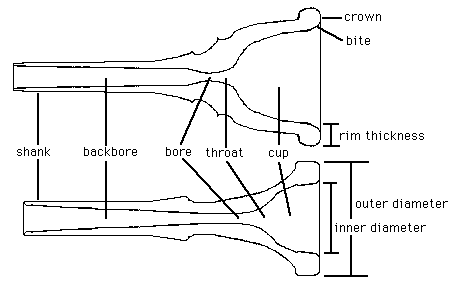Equipment
Mouthpiece Meditations Part 2: Glossary of Terms

These are some of the more prevalent arcana used to describe the elemetns of a mouthpiece. The list is not exhaustive, and definitions are based in part on the usage and context in which terms were found and on my own understanding of the concepts involved. Consider this list a point of departure, and make adjustments accordingly.
- Backbore
- The air passage from the narrowest part of the bore to the lower end of the mouthpiece. It may have a variable shape, from a straight conical flare out from the bore, or some kind of curved transition.
- Bite
- The inner edge of the rim. It can be fairly sharp, or rounded.
- Blank
- Can refer to the exterior of the mouthpiece. It is highly variable in shape, and may or may not reflect the internal shape of the mouthpiece. It may also refer to the basic shape from which a mouthpiece is formed.
- Bore
- The air passage through the mouthpiece. When listed in mouthpiece dimensions, bore size usually refers to the diameter of the narrowest part of the air passage, between the throat and backbore. In discussions, the term bore is often used just to indicate that particular region although properly it refers to the entire length of the air passage.
- Crown
- The high point on the contour of a non-flat rim. It can be centered between the inner and outer edges of the rim, or it can be offset in either direction.
- Cup
- The volume of space that starts just below the inner rim. The inside of the mouthpiece is usually curved; this curve can be extremely variable from design to design. It may have relatively straight-sloping sides like a funnel (a "V" cup), or a shape like that of a tulip (a "C" cup). Cups may be shallow or deep. Infinite variations on these two shapes are possible, and the existence of other types is not ruled out.
- Mass
- Refers to the comparative weight of a mouthpiece, occasionally with reference to how it is distributed in the mouthpiece design.
- Pitch center
- A mouthpiece that "plays on center" allows the player to hit any desired pitch dead on (neither sharp or flat), with a minimum of adjustments to the combination of mouthpiece/embouchure positioning, body posture, and breath control used to produce the pitch.
- Resistance
- Refers to the effort needed to move air through a mouthpiece and/or an instrument while attempting to play it. Sometimes referred to as back pressure, a certain amount is a necessary element in tone production and it is partly a function of how much and how fast a player needs to move air in order to produce a given pitch.
- Response
- An elusive quality; the feedback you get when you blow into a mouthpiece. Can refer to back pressure, pitch, timbre, etc.. Difficult to separate from the response of the horn. A mouthpiece with good response is one that gives more of a feeling of control over what the player is attempting to do with his embouchure.
- Rim
- The part of the mouthpiece that is placed against the lips. Rims can range from being flat across the top, to having a curved cross section (contour). Contours may be symmetrical or not. A rim has an inner diameter and an outer diameter (with corresponding edges), with the thickness being the difference between the two. These elements; the inner and outer diameters, the edges, the thickness, and the contour of the rim, are the most important considerations in physically fitting a mouthpiece to an individuals face.
- Shank
- The end of the mouthpiece that is inserted into the trombones receiver. Generally pretty similar in shape in most mouthpiece designs, length and diameter are where variation occurs. The shank size/length has to be matched to the receiver for a good fit; smaller shanks can be used in larger bores with an adapter, or the appropriate size can be substituted in mouthpieces with screw-on shanks.
- Stem
- Portion of the mouthpiece between the cup and the shank, analogous to a flower.
- Throat
- The space between the bottom of the cup and the narrowest part of the bore. Alternatively referred to as a second cup or specifically limited to indicate the narrowest part of the bore.
